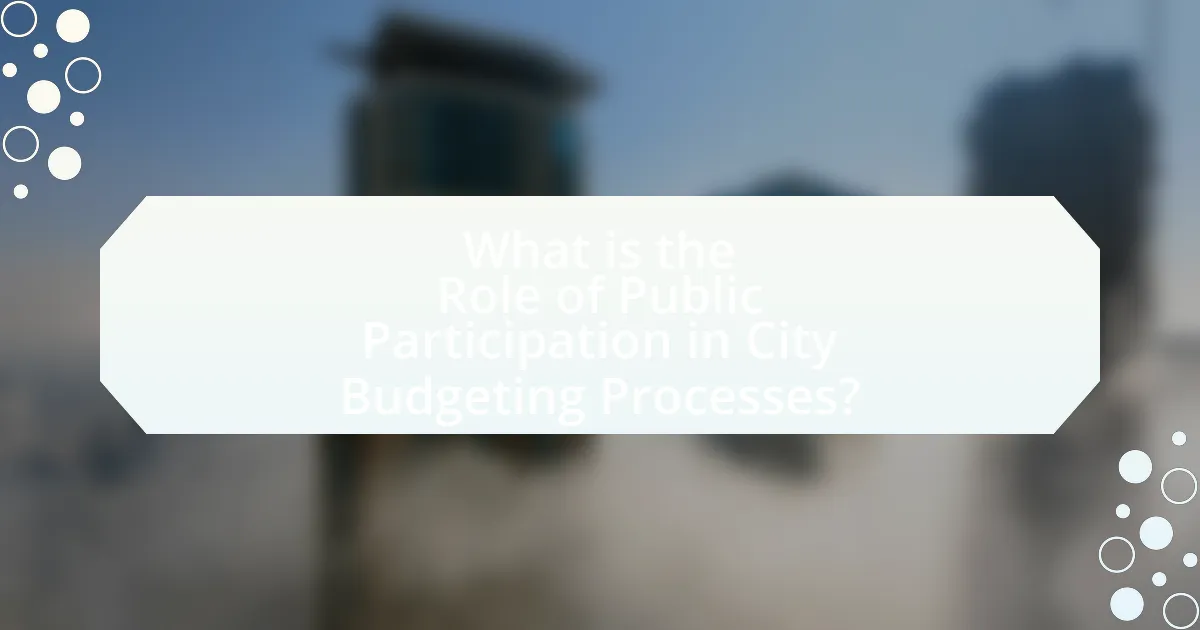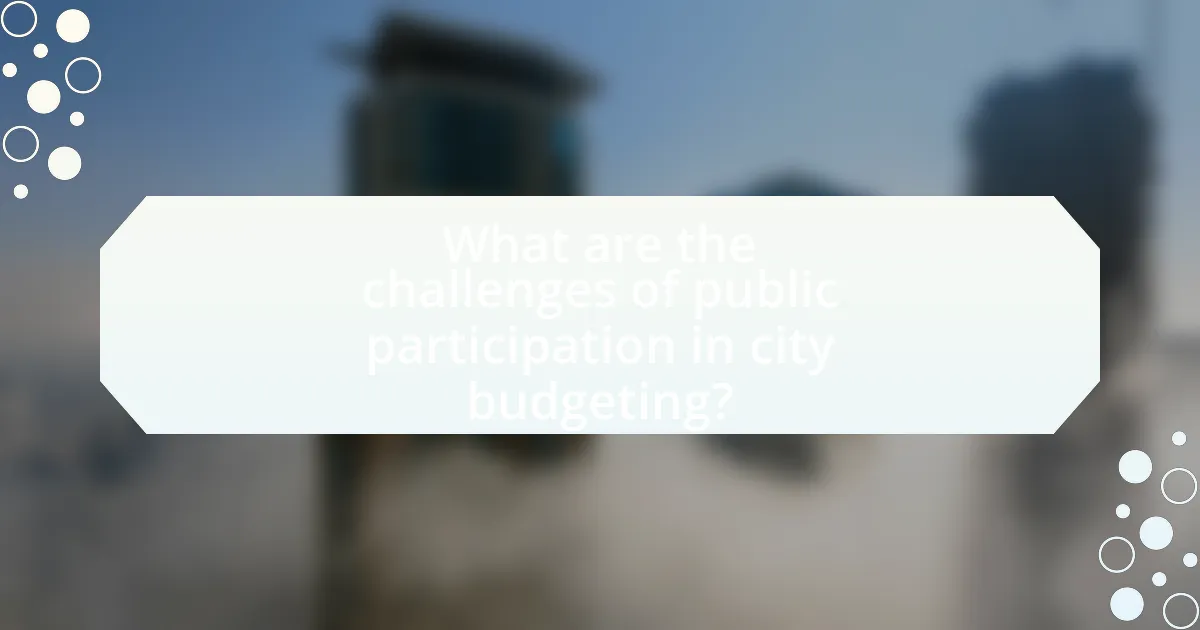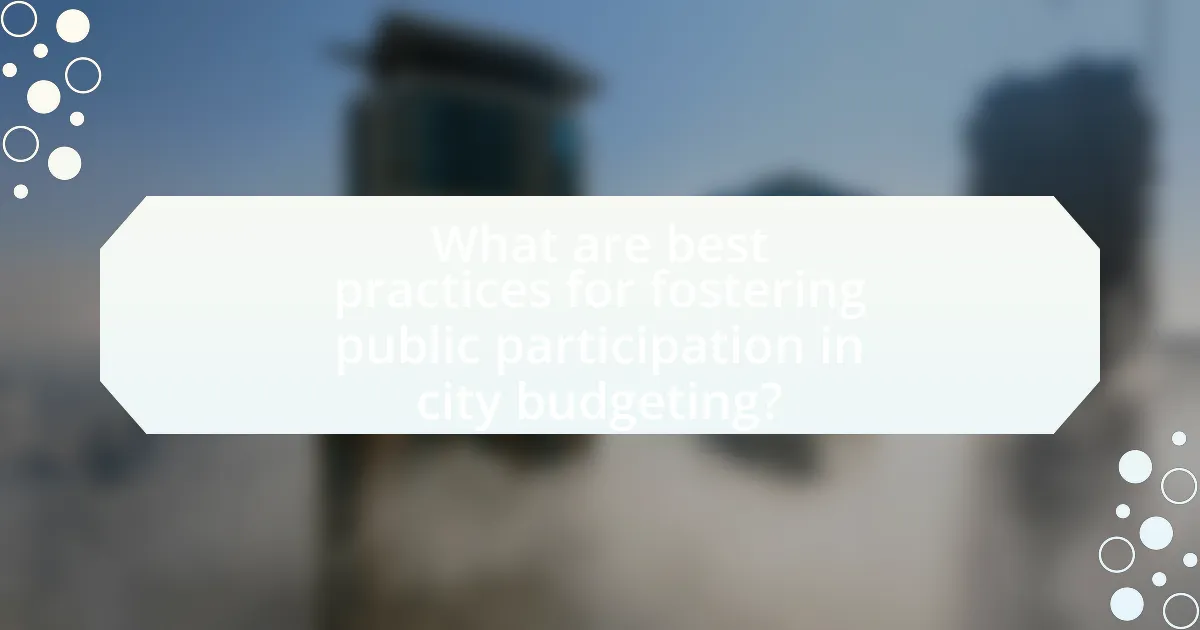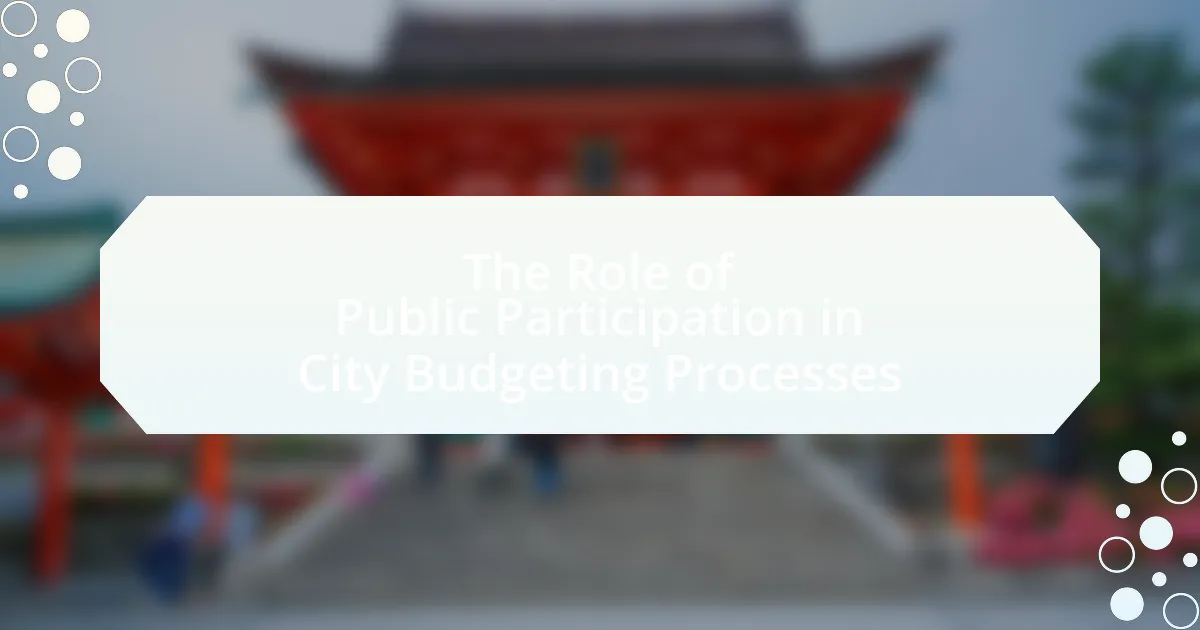Public participation is a vital component of city budgeting processes, enhancing transparency, accountability, and community engagement. The article explores how citizen involvement influences budget priorities, leading to more equitable resource allocation and improved trust in local government. Key mechanisms of public participation, such as public consultations and participatory budgeting, are examined, along with the challenges and barriers that hinder effective engagement. Additionally, the article highlights successful case studies, practical strategies for increasing participation, and the role of technology in facilitating citizen input, ultimately emphasizing the importance of inclusive governance in shaping city budgets.

What is the Role of Public Participation in City Budgeting Processes?
Public participation plays a crucial role in city budgeting processes by enhancing transparency, accountability, and community engagement. When citizens are involved, they can voice their needs and priorities, which helps local governments allocate resources more effectively. Research indicates that cities with higher levels of public participation in budgeting tend to have improved trust in government and better alignment of budgetary decisions with community needs. For instance, the participatory budgeting initiative in Porto Alegre, Brazil, has demonstrated that involving residents in budget decisions can lead to more equitable distribution of resources and increased civic engagement.
How does public participation influence city budgeting?
Public participation significantly influences city budgeting by ensuring that community needs and priorities are reflected in financial decisions. When citizens engage in the budgeting process, they provide valuable insights and feedback that can lead to more equitable allocation of resources. For instance, studies have shown that cities with participatory budgeting initiatives, such as Porto Alegre in Brazil, have seen increased investment in public services that directly address the concerns of marginalized communities. This engagement not only enhances transparency but also fosters accountability among city officials, as they are more likely to respond to the expressed needs of their constituents.
What are the key mechanisms of public participation in budgeting?
The key mechanisms of public participation in budgeting include public consultations, participatory budgeting, and stakeholder engagement. Public consultations allow citizens to provide input on budget priorities through meetings and surveys, fostering transparency and accountability. Participatory budgeting empowers community members to directly influence budget allocations by proposing and voting on projects, which has been implemented in cities like Porto Alegre, Brazil, leading to increased civic engagement and satisfaction. Stakeholder engagement involves collaboration with various groups, such as non-profits and local organizations, to ensure diverse perspectives are considered in the budgeting process, enhancing the legitimacy and effectiveness of budget decisions. These mechanisms collectively enhance democratic governance and improve public trust in financial management.
How does public input shape budget priorities?
Public input shapes budget priorities by directly influencing decision-making processes through community feedback and engagement. When citizens participate in budget discussions, they provide insights into local needs and preferences, which can lead to the allocation of funds toward services and projects that reflect those priorities. For instance, a study by the International City/County Management Association found that municipalities that actively solicit public input often see increased satisfaction with local government services, as budgets are more aligned with community expectations. This demonstrates that public engagement not only informs budgetary decisions but also enhances transparency and accountability in the budgeting process.
Why is public participation important in city budgeting?
Public participation is important in city budgeting because it enhances transparency and accountability in the allocation of public resources. Engaging citizens in the budgeting process allows for diverse perspectives, ensuring that the needs and priorities of the community are reflected in financial decisions. Research indicates that cities with higher levels of public engagement in budgeting often experience increased trust in local government and improved satisfaction with public services. For instance, a study by the International Budget Partnership found that participatory budgeting initiatives can lead to more equitable distribution of resources, as they empower marginalized groups to voice their concerns and influence budgetary outcomes.
What benefits does public participation bring to local governance?
Public participation enhances local governance by fostering transparency, accountability, and community engagement. When citizens actively participate in decision-making processes, they contribute valuable insights that reflect the community’s needs and priorities. This involvement leads to more informed policy-making and resource allocation, ultimately resulting in better public services. Research indicates that municipalities with higher levels of public engagement experience increased trust in government and improved satisfaction with local services, as evidenced by a study published in the Journal of Public Administration Research and Theory, which found that participatory budgeting initiatives led to greater civic trust and enhanced community well-being.
How does public engagement enhance transparency and accountability?
Public engagement enhances transparency and accountability by fostering open communication between government entities and citizens, allowing for greater scrutiny of decision-making processes. When citizens actively participate in budgeting processes, they can access information about how funds are allocated and spent, which reduces the likelihood of mismanagement or corruption. For instance, studies have shown that cities implementing participatory budgeting have seen increased public trust and satisfaction, as citizens feel their voices are heard and their concerns addressed. This participatory approach not only informs the public but also holds officials accountable for their financial decisions, ultimately leading to more responsible governance.

What are the challenges of public participation in city budgeting?
Public participation in city budgeting faces several challenges, including limited accessibility, lack of awareness, and insufficient resources. Limited accessibility often arises from complex budgeting processes that can be difficult for the general public to understand, which discourages engagement. A lack of awareness about public meetings or the importance of participation can lead to low turnout, as many citizens may not know how their input can influence budget decisions. Additionally, insufficient resources, such as funding for outreach efforts or staff to facilitate public engagement, can hinder effective participation. These challenges collectively reduce the effectiveness of public involvement in shaping city budgets, as evidenced by studies showing that cities with more accessible and well-promoted budgeting processes tend to have higher levels of public engagement.
What barriers exist to effective public participation?
Barriers to effective public participation include lack of access to information, insufficient outreach efforts, and socio-economic disparities. Lack of access to information prevents citizens from understanding the budgeting process, as many documents may be complex or not readily available. Insufficient outreach efforts can lead to low awareness and engagement, particularly among marginalized communities. Socio-economic disparities further hinder participation, as individuals from lower-income backgrounds may face challenges such as time constraints or lack of transportation, limiting their ability to engage in public forums. These barriers collectively diminish the effectiveness of public participation in city budgeting processes.
How do socioeconomic factors affect participation rates?
Socioeconomic factors significantly influence participation rates in city budgeting processes. Individuals from higher socioeconomic backgrounds often have greater access to resources, information, and networks that facilitate their involvement in public participation initiatives. For instance, a study by the Urban Institute found that communities with higher income levels and educational attainment tend to engage more in local governance activities, including budgeting processes. Conversely, lower socioeconomic groups may face barriers such as time constraints, lack of transportation, or limited awareness of participation opportunities, which can hinder their engagement. This disparity in participation rates can lead to unequal representation in decision-making, ultimately affecting the allocation of public resources and services.
What role does technology play in facilitating or hindering participation?
Technology plays a crucial role in facilitating participation by providing platforms for engagement and information sharing. Digital tools such as online surveys, social media, and budgeting software enable citizens to express their opinions and access relevant data, thereby increasing transparency and inclusivity in city budgeting processes. For instance, a study by the Pew Research Center found that 69% of Americans believe that technology improves civic engagement by making it easier to participate in local governance. Conversely, technology can hinder participation when access is limited, as seen in communities with low internet connectivity or digital literacy, which can exclude marginalized groups from the decision-making process. This duality highlights the importance of ensuring equitable access to technology to maximize its potential for enhancing public participation in city budgeting.
How can cities overcome challenges to public participation?
Cities can overcome challenges to public participation by implementing inclusive outreach strategies and utilizing technology to engage residents effectively. For instance, cities can host community workshops and utilize social media platforms to reach diverse populations, ensuring that all voices are heard. Research indicates that cities employing digital tools for engagement, such as online surveys and interactive budgeting platforms, have seen increased participation rates. A study by the Urban Institute found that cities that actively sought input through multiple channels experienced a 30% rise in public engagement compared to those relying solely on traditional methods. This demonstrates that a multifaceted approach can significantly enhance public participation in city budgeting processes.
What strategies can be implemented to increase engagement?
To increase engagement in city budgeting processes, implementing strategies such as community workshops, online surveys, and participatory budgeting initiatives is essential. Community workshops facilitate direct interaction between citizens and city officials, allowing for open dialogue and feedback on budget priorities. Online surveys enable broader participation by reaching individuals who may not attend in-person events, gathering diverse opinions on budget allocations. Participatory budgeting initiatives empower residents to directly influence spending decisions, fostering a sense of ownership and responsibility towards local governance. Research indicates that cities employing participatory budgeting have seen increased civic engagement and satisfaction, as evidenced by the case study of Porto Alegre, Brazil, where citizen involvement in budget decisions led to improved public services and community trust.
How can cities leverage technology to enhance participation?
Cities can leverage technology to enhance participation by implementing digital platforms that facilitate citizen engagement in budgeting processes. These platforms, such as online surveys, interactive budgeting tools, and mobile applications, allow residents to provide input, prioritize projects, and access real-time information about budget allocations. For instance, cities like Barcelona have utilized participatory budgeting software, enabling thousands of citizens to vote on budget proposals, which resulted in increased civic engagement and transparency. This approach not only democratizes decision-making but also fosters a sense of ownership among residents, leading to more informed and responsive governance.

What are best practices for fostering public participation in city budgeting?
Best practices for fostering public participation in city budgeting include implementing transparent communication strategies, utilizing technology for engagement, and providing education on the budgeting process. Transparent communication ensures that citizens are informed about budget proposals and decisions, which can increase trust and involvement. For instance, cities that publish budget documents online and hold public forums have seen higher participation rates. Utilizing technology, such as online surveys and interactive budgeting tools, allows for broader engagement, especially among younger demographics. Additionally, educating the public about the budgeting process through workshops or informational sessions empowers citizens to contribute meaningfully. Research indicates that cities employing these practices experience enhanced civic engagement and more representative budgeting outcomes.
What methods can cities use to encourage public involvement?
Cities can encourage public involvement through methods such as community workshops, online surveys, and participatory budgeting initiatives. Community workshops facilitate direct interaction between residents and city officials, allowing for open dialogue and feedback on budget priorities. Online surveys provide a convenient platform for residents to express their opinions and preferences regarding budget allocations, reaching a broader audience. Participatory budgeting initiatives empower citizens to directly influence how a portion of the city budget is spent, fostering a sense of ownership and accountability. These methods have been shown to increase civic engagement and improve the transparency of the budgeting process, as evidenced by successful case studies in cities like New York and Paris, where public participation has led to more responsive and equitable budget decisions.
How can outreach and education improve participation rates?
Outreach and education can significantly improve participation rates by increasing awareness and understanding of the budgeting process among community members. When individuals are informed about how city budgets impact their lives, they are more likely to engage in discussions and decision-making. For instance, studies have shown that communities with targeted outreach programs, such as workshops and informational sessions, experience a 30% increase in participation rates compared to those without such initiatives. This correlation highlights the effectiveness of proactive communication strategies in fostering civic engagement.
What role do community organizations play in facilitating participation?
Community organizations play a crucial role in facilitating participation by acting as intermediaries between citizens and local government. They mobilize community members, provide information about budgeting processes, and create platforms for dialogue, ensuring that diverse voices are heard. For instance, studies have shown that neighborhoods with active community organizations experience higher rates of public engagement in budgeting decisions, as these organizations often conduct outreach and education efforts that empower residents to participate effectively. This engagement is essential for fostering transparency and accountability in city budgeting processes, ultimately leading to more equitable resource allocation.
What lessons can be learned from successful public participation initiatives?
Successful public participation initiatives demonstrate the importance of inclusivity, transparency, and effective communication. These initiatives show that engaging diverse community members leads to more representative decision-making, as evidenced by the participatory budgeting process in Porto Alegre, Brazil, where citizen involvement resulted in increased investment in public services and infrastructure. Additionally, successful initiatives highlight the need for clear information dissemination; for instance, the City of New York’s participatory budgeting program utilized accessible materials to educate residents, resulting in higher engagement rates. Lastly, fostering trust between citizens and government officials is crucial, as seen in the case of the City of Chicago, where consistent follow-up on community feedback strengthened relationships and encouraged ongoing participation.
What case studies exemplify effective public participation in budgeting?
Case studies that exemplify effective public participation in budgeting include the participatory budgeting initiatives in Porto Alegre, Brazil, and New York City, USA. In Porto Alegre, the participatory budgeting process began in 1989, allowing citizens to directly influence the allocation of municipal funds, resulting in increased transparency and community engagement, with over 50% of the population participating in the decision-making process. In New York City, the participatory budgeting initiative launched in 2011 enables residents to propose and vote on capital projects, leading to over $100 million allocated based on community priorities, demonstrating a significant increase in civic involvement and satisfaction with local governance. These examples illustrate how structured public participation can enhance budgetary processes and foster community trust.
How can these lessons be applied to other cities?
Cities can apply lessons from public participation in budgeting processes by implementing inclusive engagement strategies that encourage community input. For instance, cities can adopt participatory budgeting models, which have been shown to enhance transparency and accountability, as evidenced by successful implementations in cities like Porto Alegre, Brazil, where citizen involvement led to more equitable resource allocation. Additionally, cities can utilize technology, such as online platforms for feedback and discussions, to reach a broader audience, as demonstrated by initiatives in New York City, which increased public engagement through digital tools. These approaches not only foster trust between citizens and local governments but also ensure that budgeting reflects the community’s needs and priorities.
What practical tips can cities implement to enhance public participation in budgeting?
Cities can enhance public participation in budgeting by implementing accessible community forums and digital platforms for feedback. These forums allow residents to voice their opinions and priorities, fostering a sense of ownership over budget decisions. For instance, cities like San Francisco have successfully utilized participatory budgeting, where residents directly influence budget allocations for community projects, resulting in increased civic engagement and transparency. Additionally, providing educational resources about the budgeting process can empower citizens to make informed contributions, as seen in initiatives by the City of Toronto, which offers workshops and online materials to demystify budgeting.

Leave a Reply